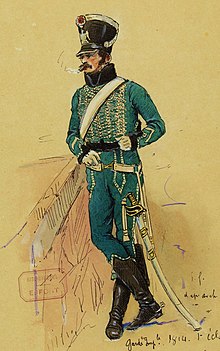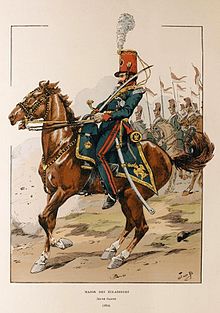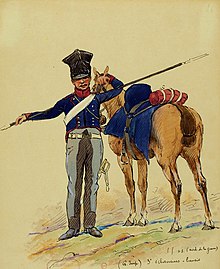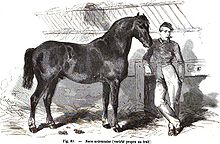Éclaireurs de la Garde impériale
|
Éclaireurs de la Garde impériale |
|
|---|---|
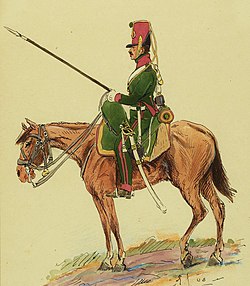 Éclaireur-dragon 1813 (drawing by Ernest Fort 1908) |
|
| active | 1813 to 1815 |
| Country |
|
| Armed forces |
|
| Armed forces | Guard impériale |
| Branch of service | Cavalerie de la Garde impériale |
| Type | Light cavalry |
| Nickname | "Éclaireurs-grenadiers" (1st regiment) "Éclaireurs-dragons" (2nd regiment) "Éclaireurs-lanciers" (3rd regiment) |
| Butcher | Coalition wars |
| commander | |
| commander | Last: Claude Testot-Ferry (1st regiment) Laurent Hoffmayer (2nd regiment) Jan Leon Kozietulski (3rd regiment) |
The Éclaireurs de la Garde impériale (Scouts of the Imperial Guard) were three regiments of light lancers of the Cavalerie de la Garde impériale of the First Empire . The naming was misleading, however, as their mission was not limited to clarification . Rather, they were initially set up primarily for the fight against the Russian Cossacks , but in the final phase of the Empire they had to take on the role of battle cavalry more and more often. The associations established at the end of 1813 distinguished themselves in the French campaign in 1814 and were dissolved after Napoleon's first and second abdication.
Formation history
background
In 1806, during the Fourth Coalition War , the French army first met Russian Cossacks . These horsemen were used for reconnaissance, vanguard, and methods of warfare previously unknown in other European armies. Their tactic, called lava , provided for the attack in a dissolved form, allowing each individual the greatest possible freedom of movement. On their forays they operated in small groups and preferred to raid smaller columns and bivouacs. Napoléon then decided to set up a comparable force. Four regiments "Éclaireurs à cheval" were planned, each with four escadrons, which should be equipped with Camargue horses because of their resilience . This project of July 9, 1806 was then given up in favor of the establishment of the "Régiment chevau-légers belges d'Arenberg", which was initially intended to fight the Cossacks, but already in 1808 to the 27th regiment of hunters on horseback of the line cavalry accordingly conventional fighting style was converted.
During the Russian campaign in 1812 , the heavy French cavalry could not pursue the continuously attacking Cossacks. They attacked suddenly and cleverly evaded the counterattacks of the French cavalry. They also intercepted couriers and interrupted the supply lines.
"Avec ces canailles de Cosaques, on ne peut tenir secret aucun mouvement"
" (With these Cossack canals, no movement can be kept secret) "
In 1813, after retreating from Russia, the Général Poniatowski evacuated Warsaw and retired to Krakow to regroup his troops there. He also decided to set up a regiment of light lancers, whose men should come entirely from the peasant class. The association was named "Régiment de Krakus". A total of 900 men could be recruited. They were mostly of small stature and sat on horses, which were also small, called Konias . On August 19, 1813 they paraded in Zittau in front of Napoléon, who was impressed and remarked:
“Je voudrais avoir dix mille hommes comme ceux-ci, montés sur des 'Konias'. C'est une excellent troupe. »
" (I would like to have 10,000 men like this on their Konias. It is an excellent group.) "
When the regiment met the emperor again on September 25, 1813 on the way to Bautzen , he was so amused by their little farm horses that he called them "ma cavalerie pygmée" ("my pygmy cavalry").
Lineup
After the defeat in the German campaign, Napoléon was confronted with the dramatic prospect of the first battle on French soil since the Revolutionary Wars and reorganized his guard through the decrees of December 4 and 9, 1813. With the latter he ordered the establishment of the “Éclaireurs de la Garde” impériale ", which were established with three regiments:
- the one he régiment of éclaireurs de la Garde impériale called "Éclaireurs-grenadiers," assigned to the regiment Grenadiers à cheval de la Garde impériale
- the 2nd e régiment des éclaireurs de la Garde impériale , called "Éclaireurs-dragons", assigned to the regiment Dragons de la Garde impériale
- the 3 e régiment of éclaireurs de la Garde impériale called "Éclaireurs-lanciers", assigned to the one he régiment de chevau-légers polonais lanciers de la Garde impériale
The concept of the French "Cossacks" was similar to that of the Krakuses, armed with lances mounted on small horses. In terms of uniforms, however, the traditional style was retained and, unlike the Polish model, no costumes based on the style of the Cossacks were used. With this troop the emperor believed to have found his counterpart to the Cossacks.
Each regiment consisted of four escadrons of 250 riders each. The personnel for the new regiments were obtained from levies from the cavalry of the "Old Guard" and from recruits who were called up. At the beginning of the French campaign, the regiments were combined to form their own brigade , but this was disbanded at the beginning of February 1814 and the individual regiments were assigned to their main troops in the guard cavalry. Two escadrons of the 3rd regiment were ordered to Paris under the chief d'escadron Skarzynski. The 1st and 2nd regiments were disbanded during the First Restoration on May 12 and June 19, 1814, respectively. The 3rd regiment remained with the regiment of the Lanciers polonais de la Garde impériale until October 1, 1815 and was then also dissolved together with this.
Regiments
1st regiment
Colonel Claude Testot-Ferry, coming from the Dragons de la Garde impériale and former aide de camp of Maréchal Marmont , became the commander of the 1st regiment . The Chefs d'escadron were: Pierre from the Chasseurs à cheval de la Garde impériale , Delavillane and Lepot from the Grenadiers à cheval de la Garde impériale and the Capitaine de Waldner-Freundstein. The latter, however, was soon replaced by the Chef d'escadron Kister.
The nominal staff strength was 53 officers and 1,005 riders and an equal number of horses. The majority of the officers - like Testot-Ferry - had been taken over directly by the Garde impériale . But there were also those from the line cavalry, such as the 4 e régiment de dragons , the 13 e régiment de dragons or the 3 e régiment de hussards .
Furthermore, 250 riders from each of the regiments of the Gardes d'honneur were to be given to the 1st regiment of the Éclaireurs, but only about a third of them were actually transferred. Napoléon then decided to call on volunteers to reach the target strength. These should be given the status of members of the “Young Guard”. Furthermore, the regiment was increased to six escadrons by delegating two escadrons from the Gardes d'honneur . Shortly before the Battle of Craonne, the unit was reinforced by horsemen from the line cavalry.
The NCOs, brigadiers , veterinarians and fittings smiths of the regiment as well as the riders of the 1st Escadron received the status of the Old Guard, while the other Escadrons belonged to the Young Guard.
The height of the soldiers was 1.78 meters for the former members of the Grenadiers à cheval , for all others 1.60 meters. This made them relatively large for their horses, whose height at the withers only had to be between 1.35 and 1.38 meters.
2nd regiment
The first commander of the 2nd regiment was Colonel-major Leclerc, who was replaced on December 17, 1813 by Colonel Laurent Hoffmayer - until then the commander of the 2 e régiment de dragons . Escadron commanders were Parizot and Lebrasseur from the Chasseurs à cheval de la Garde , Toustaint from the 13 e régiment de chasseurs à cheval and Bourbon-Busset from the 27 e régiment de chasseurs à cheval . Here, too, the batches of the Old Guard were assigned, the riders of the Young Guard. The NCOs came from different units - from the Old Guard, the Line Cavalry or the Gardes d'honneur . The nominal strength was 1,000 riders in four escadrons, plus the officers. The tasks of this regiment were courier services, but in practice it was used for a variety of tasks. In 1814 the heavy personnel losses had to be made up with everything that was available. Artillerymen and even sailors were incorporated. In contrast to the 1st regiment, there were no members of the Gardes d'honneur to be found here. At the beginning of the French campaign in 1814, the regiment in Paris only had 23 officers, 829 riders and 498 horses. Only 502 men were involved in the first battles of the Napoleonic Army . Two months later the regiment consisted of only 200 riders.
3rd regiment
The commanding officer was Major Jan Leon Kozietulski, ex-escadron commander in the regiment of the Lanciers polonais de la Garde impériale . The 1st Escadron was commanded by Szeptycki, the 2nd by Skarzynski, the 3rd by Józef Bonawentura Załuski and the 4th by Wasowicz. The officers of the staff all came from the regiment of the Lanciers polonais de la Garde - thus belonged to the Old Guard, the other officers and the riders belonged to the Young Guard. With a few exceptions - according to the two regimental doctors - the officers came from Poland.
On December 9, 1813, the regiment was the one he lanciers de la Garde reduced from seven to four squadrons. The riders thus freed were transferred to the 3rd regiment of the Éclaireurs. The Polish elite battalion in the Sedan recruit depot was then used to complete the project .
At the end of January 1814, the regiment had a staff of 52 officers and 624 riders, of which 640 came from the depot in Givet (Ardennes) and 36 from the depot in Chantilly . Two months later the workforce was 860 men. After Napoleon's abdication, 597 Polish horsemen left the French service and returned to their homeland under the command of Chef d'escadron Zielonka.
Fighting
The new units took part in the retreat fighting of 1814 in France, where they fought a number of skirmishes against the Russian Cossacks. They also carried out reconnaissance and outpost service, but were mainly used in cavalry attacks, for example in the Battle of Brienne , the Battle of Montmirail and the Battle of Craonne , where Colonel Testot-Ferry led the 1st regiment against the Russian artillery. The troops were also used in the Battle of Paris .

From Brienne to Troyes
The Éclaireurs received their baptism of fire on January 29, 1814 in the battle of Brienne against the Prussian-Russian troops. The Capitaine Drion of the 1st regiment was wounded here. Despite being outnumbered, Napoléon began the battle of La Rothière on February 1, 1814 . During the battle, the Général de division Nansouty ordered the Général de brigade Dautancourt to attack the Russians with his brigade.
He complied and attacked the opposing cavalry and infantry repeatedly, but after initial successes, the brigade had to withdraw from the superior force. The Éclaireurs lost the Capitaine Zaluski, who was captured, and 15 horsemen to the fallen and wounded. On February 7th, Napoleon ordered the retreat to Troyes .
From Champaubert to Craonne
Napoléon intended to repel the enemy offensive from Troyes and successfully attacked General Olsouviev's army corps on February 10, 1814 at the Battle of Champaubert . An escadron of the 3rd regiment under Chief d'escadron Skarzynski took part in the attack by the French cavalry and the subsequent destruction of the Russian infantry carriages. The next morning, during the battle of Montmirail , the 1st and 2nd regiments, under the command of Colonel Testot-Ferry, attacked the Russians again together with the Guard Dragons and took a number of prisoners. The French victories in the battle of Château-Thierry , the battle of Vauchamps and the battle of Montereau improved the military situation of the French and allowed better protection of the road to Paris.
The Éclaireurs took part in the pursuit of the troops of the defeated Field Marshal Blücher and got into battles with Cossack patrols several times. After the surrender of Soissons on March 3, Napoléon ordered the Général Nansouty , commander of the guard cavalry, to secure the bridge in Berry-au-Bac so that the French armed forces could cross the Aisne. On March 5, the Nansouty division, together with the "Lanciers polonais" of Général Pac , appeared in front of the city and attacked the Cossacks encountered there. The chief d'escadron Skarzynski of the 3rd regiment seized the bridge and with the help of parts of the guard cavalry dispersed the remaining Cossacks. This brought Skarzynski a commendation from Général Dautancourt, who referred to him as "le brave Skarzynski".
In the battle of Craonne, the infantry of Maréchal Ney suffered heavy losses from Russian artillery. To save the situation, Colonel Testot-Ferry sent the 1st Regiment to attack the enemy artillery positions. His horse was killed in the process, and the Chef d'escadron Kister was among the dead. A counterattack by the Russian cavalry threw the Éclaireurs-grenadiers back to their starting positions. Testot-Ferry, who took over the post of the wounded Général de Levesque de Laferrière , ordered a new attack on the batteries of the coalition troops, which could eventually be taken with heavy losses. Testot-Ferry was appointed Baron de l'Empire by Napoléon for this action.
From Laon to Arcis-sur-Aube
On March 10, the French attacked the von Blücher army again and established themselves on the Laon plateau . The Éclaireurs detachments at the head of the guard cavalry attacked parts of the Allies who were retreating to Laon. However, since the French infantry were thrown back elsewhere, Napoléon ordered the retreat. At the same time Soissons was recaptured by a French division - including about 100 Éclaireurs of the 2nd regiment. On March 13, the French army stood before Reims , which was defended by the Prussian and Russian troops of General Saint-Priest .
In this battle near Reims, the Éclaireurs attacked at the head of the Gardes d'honneur of Général de Ségur . The Capitaine Gaiette of the Éclaireurs-dragons fell. The chief d'escadron Szeptycki captured a Prussian infantry battalion at the head of an escadron of the 3rd regiment. On March 19, when Napoléon marched against the Schwarzenberg army, the Letort division with the 1st Regiment of Éclaireurs wrested the place Méry-sur-Seine from the Allies and was able to take away a war bridge train from the Bohemian Army .
On March 20, Napoléon met the troops of Schwarzenberg in the battle of Arcis-sur-Aube . The Allied cavalry attacked the Chasseurs à cheval de la Garde and the Éclaireurs-grenadiers, but the overwhelming force pushed them back onto Méry, where they were unexpectedly caught by the cavalry of Général Lefebvre-Desnouettes . When the imperial general staff threatened to be surrounded by Cossacks, they were pushed back by the staff guard and the éclaireurs of Colonel Testot-Ferry. Colonel Testot-Ferry's horse was killed and he himself was taken prisoner.
"[...] soon after the emperor's entourage noticed the disappearance of the intrepid major-colonel of the Éclaireurs de la Garde, it broke out into deep sorrow, as it was assumed that he had been killed"
The losses were high and particularly affected the 2nd and 3rd regiments.
Saint-Dizier and the Battle of Paris
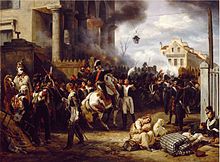
On March 24, the Allies decided to march on Paris with their combined forces. General Wintzingerode received the order to divert the French troops with an action. On March 26th, he therefore occupied Saint-Dizier with a small contingent and was attacked on March 26th by the French guard cavalry, which appeared on the spot that day. The emperor himself took the lead, the Russians were quickly overrun. The Éclaireurs could again distinguish themselves.
On March 30, the coalition army appeared outside Paris and attacked the 30,000 defenders. The Général d' Ornano handed over his command of the guard cavalry to the Général Dautancourt. This motley troop consisted of only 800 riders - made up of Grenadiers à cheval de la Garde impériale , Chasseurs à cheval de la Garde impériale , Lanciers polonais de la Garde impériale , Mamelouks de la Garde impériale , Dragons de la Garde impériale and Éclaireurs - , mainly from the 3rd regiment. A détachement of this regiment took part in the battle of Claye on March 29th together with the Régiment des Krakus . On the same day, most of the riders accompanied the Empress Marie Louise to Blois . The entire brigade was only able to bring together 330 horsemen to defend Paris. Major Kozietulski, in command of the 3rd regiment, fought the attackers at Aubervilliers and tried to slow their advance, while the rest of the guard cavalry fought off Montmartre and in the vineyards of Batignolles. Attacked by overpowering infantry and under artillery fire, the Dautancourt Brigade retreated to the capital and assembled on the Boulevard des Italiens , where they learned of the surrender of Paris.
The brigade was ordered to go to Villejuif , and on March 31, the Capitaine Horaczko, as the commander of a department of the 3rd regiment, had the bridges in Vitry and Choisy-le-Roi blown up. It was the final act of war of the Éclaireurs de la Garde impériale.
Uniforms
1st regiment
The riders
A shako of the same pattern served as headgear for everyone . It consisted of a black body with a white trim at the top and soutaches of the same color . The chin straps were covered with white metal, and the eagle on the front of the shako was made of white metal. The black-tipped scarlet plume was fastened under the cockade .
The former Gardes d'honneur , however, kept their scarlet shako, although the border was changed to differentiate them from the Gardes d'honneur . The camp cap was green with a white border and scarlet passepoils .
The uniforms of the 1st Escadron, which was counted as part of the Old Guard, were very similar to a hussar uniform and thus largely corresponded to the uniform of the Gardes d'honneur . A dark green dolman with a pelisse with lacing, braids and soutaches made of white wool was worn. The buttons were white metal. The dolman had a scarlet collar and cuffs, and a white lining. The pelisse was trimmed in black fur, the lining corresponded to that of the dolman.
The other three escadrons, who belonged to the Young Guard, wore a uniform similar to the hunters on horseback of the line, a dark green tunic called "Kinski". It had red badges and white buttons. The pants were gray linen with scarlet stripes.
trumpeter
The trumpeters of the 1st regiment wore a shako like the other riders, but the Pelisses were different. These were light blue like those of the trumpeters of the rest of the guard cavalry, the lacing, braids and soutaches were white. The braids of the trompette majors (regimental trumpeters) were patterned alternately white and blue. The sash was white and carmine.
Officers and NCOs
The shakos were like those of the riders. The pelisse was equipped with green and white interwoven cords, braids and soutaches. The officers wore white soutaches on the shako. The dolmans were the same as those of the riders, only the badges of rank were made in white. The pants were blue with white lampasses .
2nd regiment
Général Drouot wrote a message to Napoléon on December 7, 1813:
“The uniforms of the 2nd Éclaireurs are the same as those of the Chevau-légers lanciers de la ligne, the color of the tunic is that of the dragoons of the Guard. The 2nd Éclaireurs have taken over the chest discounts of the Dragoons and have therefore adapted their uniforms to them. "
equestrian
The Éclaireurs-dragons wore a cylindrical shako of crimson color with a black trim on the upper edge - bordered by two soutaches of the same color. On the back there was a neck protector made of black leather, the chin strap was also made of black leather. Above the Kokarde a was Pompon secured, held with the aid of a button, was in turn enclosed by a double light red tress. The cords were red with no raquettes. The tunic was dark green with white metal buttons and silver lacing - identical to that of the Éclaireurs-grenadiers of the Young Guard, but with crimson badges. A green vest was worn for service in the stable. There were two different trousers, one made of green fabric without leather trimmings with double crimson lampasses and one made of linen-gray sheepskin without lampasses. The bandolier was made of black leather.
trumpeter
The uniform of the trumpeters of the 2nd regiment corresponded in style to that of the riders, but was sky blue in color. The chest discount was crimson, as was the collar and the cuffs. Both were bordered with a bright red border.
Officers and NCOs
The uniforms of the NCOs of the 2nd regiment differed little from those of the riders, the shako of the officers only in the arrangement of the border and the equipment with golden soutaches, plus a lanyard with raquettes. The tunic was made of finer cloth than that of the common horsemen. The breeches were gray with gold lampasses.
3rd regiment
The uniforms were similar to the Lanciers polonais de la Garde impériale with a capka and a dark blue kurtka .
equestrian
The Tschapka (830 specimens were delivered by Hutmacher Chardon) were the same as those of the Lanciers rouges of the Young Guard, only the color was different. The kurtka was the same as that of the Old Guard lanciers polonais , but of inferior quality. It was made of dark blue cloth with a crimson collar, lapels, passepoils, and chest discounts. White epaulettes and aiguillettes were only worn by the Éclaireurs assigned to the 1 er lanciers de la Garde , the others only wore a single “Contre-épaulette”. Like the “Lanciers polonais de la ligne”, the 3rd regiment wore a blue and white striped belt. The breeches were made of linen gray sheepskin without lampasses.
trumpeter
The chapka was made of white fluted cloth with a lanyard with raquettes and crimson and white tassels . A light red pompon was attached to the front of the chapka over the Maltese cross. The kurtka was made of sky-blue cloth with crimson markings. The epaulettes and the aiguillette were crimson and white. Chest discounts, collar and cuffs were decorated with a silver border.
Officers and NCOs
The regiment's NCOs wore the uniforms of the Lanciers polonais de la Garde impériale with silver badges. The officers wore a dark blue kurtka with crimson parade discounts . The badges and borders were made in silver officer's quality.
Horses and bridles
The Russian campaign in 1812 had reduced the number of horses so much that Napoléon could only carry out his campaign in Germany in 1813 with weakened cavalry forces. At the end of the year the retreat to France began, and the German lands were left with their wealth of large horses - which were urgently needed for the heavy cavalry. This fact forced the emperor to resort more to French horses, which had previously received less attention. As a remonten for the Éclaireurs, Napoléon determined a height at the withers of 4 pieds 2 pouces to 4 pieds 3 pouces (1.21 to 1.30 meters), the age should be five or six years. These horses came mainly from the Pyrenees , the Massif central , the Ardennes and the Camargue . The Colonel Testot-Ferry stated that he preferred the Ardennes horses :
"[...] of small stature but strong and with a lot of stamina"
The horses' bridles and harness were very different, as the existing stocks of the cavalry were used up. The weight that the horses had to carry was reduced, everything on the horse harness that was not absolutely necessary was reduced. This was also reflected in the costs - an éclaireur had 63 francs available for the procurement of the horse harness, while 113 francs were spent on a chasseur à cheval or a hussar.
literature
- Alain Pigeard, Vincent Bourgeot: La Cavalerie de la Garde Impériale. Soteca, 2013, ISBN 979-10-91561-58-7 .
- Alain Pigeard: Les différentes unités de l'armée du duché de Varsovie - Krakus. In: Tradition. No. 8, January 1999: Napoléon et les troupes polonaises 1797–1815. De l'Armée d'Italie à la Grande Armée.
- Jean Brunon, Raoul Brunon; Pierre Benigni, Louis Frégier (Ill.): Les éclaireurs de la Garde impériale. 1813–1814 ( memorial from March 25, 2019 in the Internet Archive ). Collection Raoul et Jean Brunon, Marseille 1962, OCLC 67376767 (PDF; 3 kB).
- Gérard Jaeger: Les éclaireurs de la Garde impériale. In: Tradition. No. 164, 2001.
- Jean Tranié, Juan-Carlos Carmigniani: Les Polonais de Napoléon. L'épopée du 1 er régiment de lanciers de la garde impériale. Copernic, Paris 1982, OCLC 144689780 ( limited preview in Google Book search).
- Jean Tranié, Juan-Carlos Carmigniani: Napoléon. 1814. La campagne de France. Pygmalion / Gérard Watelet, Paris 1989, ISBN 978-2-85704-301-0 ( limited preview in the Google book search).
- François-Guy Hourtoulle; Jack Girbal, Patrice Courcelle (Ill.): Soldats et uniformes du Premier Empire. Histoire & Collections, Paris 2004, ISBN 978-2-913903-54-8 .
- G. Charmy: Splendeurs des uniformes de Napoléon. La Garde impériale à cheval. Charles Hérissey, Janzé 2003, ISBN 978-2-914417-10-5 ( limited preview in Google book search).
- Ronald Pawly; Patrice Courcelle (Ill.): Napoleon's Scouts of the Imperial Guard (= Men-at-Arms , No. 433). Osprey Publishing, Oxford 2006, ISBN 978-1-84176-956-1 ( limited preview in Google Book Search).
Footnotes and individual references
- ↑ Brunon, 1962, pp. 47 and 48
- ↑ The name Krakus refers to Krakow. The majority of the recruits came from this region.
- ↑ Pawly, 2006, p 6
- ↑ Brunon, 1962, p. 10
- ↑ Pigeard, Bourgeot, 2013, p 75
- ↑ It is not known whether and when they got there.
- ↑ a b Brunon, 1962, p. 18
- ↑ The soldiers of the Old Guard received a higher pay than the rest.
- ^ Colonel as representative of the regimental commander
- ↑ Brunon, 1962, p. 33
- ↑ Brunon, 1962, p. 34
- ↑ Brunon, 1962, pp. 34, 35
- ↑ Pawly, 2006, pp. 20, 21
- ↑ Brunon, 1962, p. 58
- ↑ the brave Skarzynski
- ↑ Brunon, 1962, p. 62
- ↑ Baron of the Empire
- ↑ Brunon, 1962, p. 63
- ↑ Pawly, 2006, p. 38
- ↑ Pawly, 2006, p. 40
- ↑ Brunon, 1962, pp. 66, 67
- ↑ Brunon, 1962, p. 71
- ↑ a b Jaeger, 2001, p. 32
- ↑ as the only unit in the French army
- ↑ tennis racket-like mesh
- ↑ Brunon, 1962, p. 31
- ↑ shoulder cords
- ^ Polish line lancers
- ↑ Pawly, 2006, p. 32

